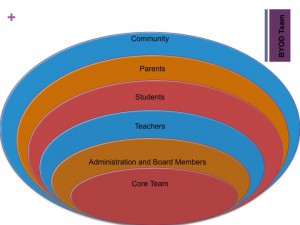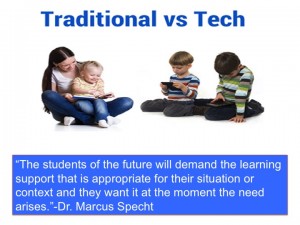We need to have a clear BYOD policy defining what is, and what is not, acceptable on a school’s network. We must clarify expected behavior and set consequences for non-compliance. All stakeholders, including students, must have ownership of these rules and consequences so that they are able to adhere to the policy over the long run. Moreover, teaching and learning policy must include BYOD policy and its effective use in teaching and learning. An inclusive policy developed by a BYOD team that involves all stakeholders may help achieve all of these objectives. Possible roles of the BYOD team members are explained below.

The Core Team, may include instructional designers and technology specialists who support the district while planning the policy document, exploring current technologies, calculating the feasibility of available technology, troubleshooting, and teacher training.
Administration and board members will support the core team and help teachers test suggested technologies, plan, run, and attend professional development. Teachers may be provided an extra stipend if additional planning or workload is required.

A dedicated group of focused students may participate during the planning phase. Being digital natives and future consumers of BYOD programs, their responsibilities include learning and testing new educational technologies and providing feedback to the teachers, administrators and core team in order to troubleshoot problems, if any. Students may help teachers design classroom management rules as well to promote student ownership over the BYOD policy. Students involved in the planning program may be given additional school credit upon successful completion of the course.
Parents can provide input that may weigh heavily on the program design as they make major decisions for their children under the age of 18.
A BYOD team could involve input from community or local business owners as well, especially if the district is seeking community funding. Moreover, business trends will help the BYOD team to decide which skills need to be taught to the future employee (student) to be successful after 5-10 years.
Hardware and software infrastructure of BYOD Policy: The BYOD team will decide the hardware and software structure for BYOD by contacting local vendors and network specialists. Hardware structure includes the selection of a wireless infrastructure, a network that is able to handle large numbers of devices at an appropriate speed if all students log on at the same time, is cost-effective, and has enough bandwidth for multimedia. Data security, protection from viruses and malware, inappropriate use of internet (filtered connections) are also some of the most important considerations to make while forming a policy. Requiring three different types of authentication may help, for example in a segmented network, teachers, students, and guests will have different networks to avoid security conflicts. When it comes to purchasing mobile devices, parents and students should have a general set of recommendations and considerations so that it does not become an issue of haves and have-nots.

Acceptable use of policy: The BYOD team will develop many documents for parents and students to communicate the acceptable use of policy, digital citizenship curriculum, parents letters, research based classroom management rules that are flexible and can be modified by the classroom teachers based on their own needs, and professional development sessions to train teachers so that they can put pedagogy first and promote 21st century skills while using BYOD in their classroom.
Tech team: Schools will need a tech team to address all IT/hardware/software issues on a daily basis. This service should be provided 24/7.
Other resources: An online library is also advantageous if a school is going to utilize BYOD. Moreover, there should be additional BYOD devices available in school for all those students who cannot afford their own device. This service should be available 24/7. These devices can be issued on a daily, weekly/monthly basis with proper login/logout information. Students can become each other’s resources by sharing their devices with each other, making the best use of different devices.
Ongoing Professional Development: As BYOD technology is changing rapidly, teachers need to be trained at the same pace. Thus, the BYOD team will analyze the market and plan the professional development sessions accordingly.

